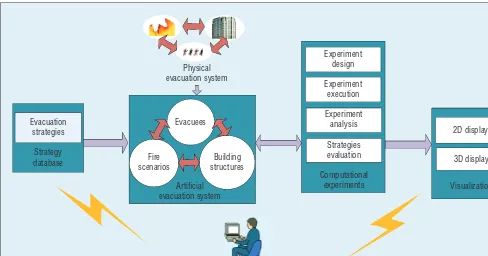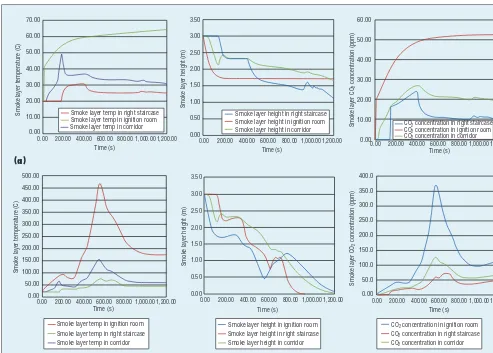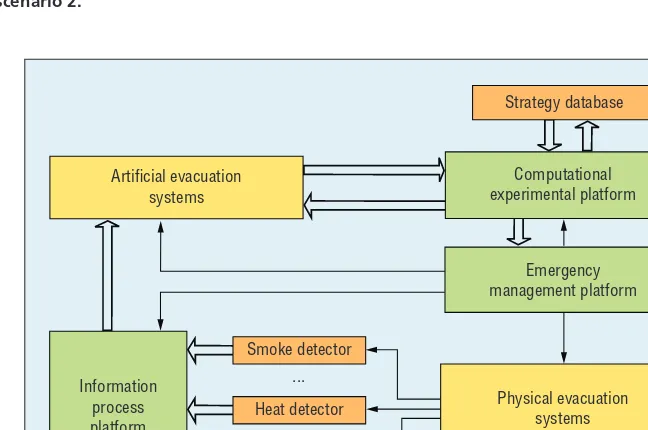Editor: Liuqing Yang, Colorado State University, [email protected]
A CPSS Approach for
Emergency Evacuation
in Building Fires
Yuling Hu, Beijing Institute of Technology and Beijing University of Civil Engineering and Architecture
Fei-Yue Wang and Xiwei Liu, Chinese Academy of Sciences
to have emergency evacuation plans in place be-fore fi re outbreaks occur. However, there are too many factors involving uncertainty, diversity, and complexity in evacuations. How, then, can we model human behaviors during evacuation pro-cesses? And how do we verify or evaluate those prearranged emergency plans? Furthermore, how can we guide evacuations timely and effectively under varied, changing scenarios?
To address these problems, we propose a cyber-physical-social systems (CPSS) approach based (ACP) methodology using artifi cial systems,
com-putational experiments, and parallel execution.1–3
CPSS is the extension of cyber-physical systems (CPS), which integrate with human and social characteristics and bridge the physical world,
cy-berspace, and human society together.4 In a CPSS
approach, building structures, fi re scenarios, evac-uees, and managers can be fully connected and in-teractive. To model the complex processes of evac-uations, artifi cial evacuation systems are built and used to determine evacuation options for the phys-ical evacuation systems. Based on the artifi cial evacuation systems, such prearranged emergency plans can be tested and evaluated by computa-tional experiments. Then, constructing data-driven parallel mechanisms between the artifi cial evacuation systems and the physical evacuation systems is the ultimate way to achieve evacuation guidance in real time.
System Framework
As Figure 1 shows, the strategy database, artifi -cial evacuation system, computational experiment
platform, and visualization output are the main components. Various emergency evacuation strat-egies, static or dynamic, are included in strategy databases, and are applied to artifi cial evacuation systems. The computational experiment platform can be considered as the laboratory for conducting evacuation experiments.
As the counterparts of actual and physical evac-uation systems, artifi cial evacevac-uation systems are developed by three interactional components:
• Building structures. According to the needs of research, in the artifi cial evacuation systems we can fl exibly construct different building spatial distributions and explore the infl uences of these different structures on evacuation effi ciencies. • Fire scenarios. Obviously, different fi re
scenar-ios will distinctly impact evacuees’ psychology and physiology and change the evacuation effi -ciencies, even with the same strategy.
• Evacuees. It’s been verifi ed that agent-based modeling methods accurately imitate evacuees— from physiological and psychological
character-istics to movements and behaviors.5 To
differen-tiate and distinguish among the evacuees, each individual agent should have some basic physi-ological and psychphysi-ological attributes. Addition-ally, the agent needs capabilities for external fi re environment perception and decision making.
After the use of artifi cial evacuation systems for modeling evacuation processes, we can design and perform controllable evacuation experiments with the computational experiment platform, which enables us to evaluate and quantitatively analyze various factors, especially human factors on evac-uation effi ciency, a diffi cult problem to address thus far. According to the problems and objec-tives of investigation, many existing experimental
L
iving with high-rise buildings or skyscrapersdesign theories and methods, such as single-factor or multifactor experi-mental design, orthogonal or uni-form experiment design, and so on, can be utilized in evacuation
compu-tational experiments.6
The visualization is also an im-portant part of our system. With the development of virtual reality tech-nologies, visualization technologies can help us easily identify evacuation bottlenecks or congestion changes. That’s helpful for improving or opti-mizing evacuation strategies.
Strategy Evaluation
By integrating the agent, grid comput-ing, and fire simulation technologies, we construct an artificial evacuation system (see Figure 2). The building structures, individual attributes, oc-cupant distributions, and fire scenar-ios can be flexibly altered according to investigative needs or in reference to the actual evacuation systems. Fig-ure 3 shows two representative fire scenarios to illustrate the develop-ments of fire environdevelop-ments over time.
Note that this environment informa-tion is perceived by individual agents and it affects their behaviors and movement capabilities in real time.
Evacuation strategies can by eval-uated by applying them to artificial evacuation systems. Considering the strategies listed in Table 1, uncertain-ties or random factors are introduced by the Monte Carlo method and
some statistical knowledge in
experi-ments and evaluation.7 With required
safe egress time (RSET) as the key performance index, Figure 4 shows computational experimental results on two fire scenarios with different strategies. Clearly, the results show each strategy’s evacuation efficiency while also revealing each fire scenar-io’s effects.
Figure 1. System framework. The main components are the strategy database, artificial evacuation system, computational experiment platform, and visualization output.
Physical evacuation system
Evacuees Evacuation
strategies Strategy database
Artificial evacuation system Fire
scenarios
Building structures
Computational experiments
Strategies evaluation Experiment execution Experiment
analysis Experiment
design
Visualization 3D display 2D display
(a) (c)
(b) (b)
Obviously, improved or optimal strategies can be obtained by such com-putational experiments and be used to train managers or drill occupants to al-leviate the effect of disasters.
Evacuation Guidance
In our approach, the most significant function is to guide evacuation in real
time. Considering the dynamics and uncertainties in evacuation processes,
the data-driven parallel mechanism8
between the actual evacuation tems and the artificial evacuation sys-tems is important and useful.
In real-world applications, we can use the artificial evacuation systems
to emulate the actual evacuation
system for learning and training. Through analysis or evaluation of evacuees’ behaviors on computers with artificial systems in advance, we can improve and optimize the actual evacuation process’s performance. At the same time, various information and data collected by actual sensors can be used to calibrate the artificial
50.00
Smoke layer temperature (C)
Smoke layer temperature (C)
Smoke layer height (m)
3.50 400.0
Smoke layer height (m)
Smoke layer CO
2
concentration (ppm)
Smoke layer CO
2
concentration (ppm)
10.00
0.00 200.00 400.00 600.00 800.00 Time (s)
1,000.00 1,200.00
0.00 200.00 400.00 600.00 800.00 Time (s)
1,000.00 1,200.00 0.00 200.00 400.00 600.00 800.00 Time (s)
1,000.00 1,200.00 0.00 200.00 400.00 600.00 800.00 Time (s)
1,000.00 1,200.00 0.00 200.00 400.00 600.00 800.00
Time (s)
1,000.00 1,200.00 0.00 200.00 400.00 600.00 800.00 Time (s)
1,000.00 1,200.00 Smoke layer height in right staircase
Smoke layer height in ignition room Smoke layer height in corridor
Smoke layer height in ignition room Smoke layer height in right staircase Smoke layer height in corridor
CO2 concentration in right staircase
CO2 concentration in ignition room
CO2 concentration in corridor
Smoke layer temp in right staircase Smoke layer temp in ignition room Smoke layer temp in corridor
Smoke layer temp in ignition room Smoke layer temp in right staircase Smoke layer temp in corridor
CO2 concentration in ignition room
CO2 concentration in right staircase
CO2 concentration in corridor
(a)
(b)
Table 1. Evacuation strategy database.
Strategy Notes
Strategy1 The shortest-path evacuation The shortest-distance export evacuation strategy.
Strategy2 Exit equal-density evacuation Evacuee is evenly distributed to stairs or exits.
Strategy3 Fire floor prior evacuation It combines with the shortest-distance export evacuation.
Strategy4 Fire floor prior evacuation It combines with the exit equal-density evacuation.
evacuation systems and run them in parallel with actual evacuation pro-cesses in real time. Figure 5 shows the data-driven parallel mechanism.
T
he CPSS approach we proposedhere provides a tool to verify or eval-uate emergency evacuation plans. It enables operators to explore the pos-sible consequences of decisions. In addition, by building a data-driven parallel mechanism between actual and artificial evacuation systems, this makes it possible to guide evacua-tion processes effectively in real time. We hope further work using this ap-proach will significantly improve fire emergency management and public safety.
Elapsed people total
600 Elasped time (s)
600 700 800 900 1,000 1,300
Elapsed people total
600 Elasped time (s)
600 700 800 900 1,000 1,100 Strategy4
Heat detector Physical evacuation systems Video detector
... ...
Figure 4. The results of a computational experiment, using four strategies in each scenario (refer to Table 1 for the strategies). (a) The relationship between elapsed time and the number of people who escaped in scenario 1. (b) The relationship between elapsed time and the number of people who escaped in scenario 2. (c) Required safe egress time (RSET) for the strategies in scenario 1. (d) RSET for the strategies in scenario 2.
This work was supported by Beijing Munici-pal Education Commission grant 051201515 and by National Natural Science Foundation of China grants 61233001 and 91024030.
References
1. F.-Y. Wang, “Toward a Paradigm Shift in Social Computing: The ACP Ap-proach,” IEEE Intelligent Systems,vol. 22, no. 5, 2007, pp. 65–67.
2. F.-Y. Wang, “Parallel Control and Man-agement for Intelligent Transportation Systems: Concepts, Architectures, and Applications,” IEEE Trans. Intelligent
Transportation Systems, vol. 11, no. 3,
2010, pp.1–9.
3. B. Ning et al., “ACP-Based Control and Management of Urban Rail Transporta-tion Systems,” IEEE Intelligent Systems, vol. 26, no. 2, 2011, pp. 84–88.
ligent Enterprises: From CPS to CPSS,”
IEEE Intelligent Systems, vol. 25, no.
4, 2010, pp. 85–88.
5. Y.-L. Hu et al., “ACP-Based Research on Evacuation Strategies for High-Rise Building Fire,” ACTA
Automati-ca SiniAutomati-ca, vol. 40, no. 2, 2014,
pp. 185–196.
6. F.-H. Zhu et al., “A Case Study of Eval-uating Traffic Signal Control Systems Using Computational Experiments,”
IEEE Trans. Intelligent Systems, vol.
12, no. 4, 2011, pp. 1220–1226. 7. X. Zhang et al., “A Probabilistic
Oc-cupant Evacuation Model for Fire Emer-gencies Using Monte Carlo Methods,”
Fire Safety, vol. 58, no. 1, 2013, pp. 15–24.
8. F.-Y. Wang, “Parallel Control: A Meth-od for Data-Driven and Computational
vol. 39, no. 4, 2013, pp. 293–302.
Yuling Hu is a PhD candidate at the Beijing Institute of Technology and an associate professor at Beijing University of Civil En-gineering and Architecture. Contact her at [email protected].
Fei-Yue Wang is the vice president of the Institute of Automation at the Chinese Academy of Sciences. Contact him at feiyue. [email protected].
Xiwei Liu is an associate professor of engi-neering at the Chinese Academy of Sciences. Contact him at [email protected].
Selected CS articles and columns are also available for free at http://ComputingNow.computer.org.
NEW
STORE
Save up to
40
%
on selected articles, books, and webinars.
Find the latest trends and insights for your
• presentations
• research
• events


